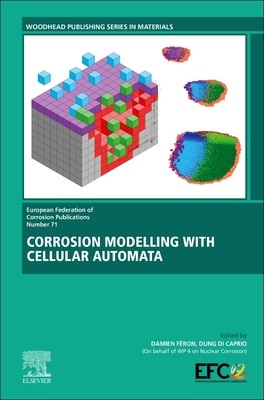
- We will send in 10–14 business days.
- Publisher: Woodhead Publishing
- ISBN-10: 0443137862
- ISBN-13: 9780443137860
- Format: 15.2 x 22.9 x 1.3 cm, hardcover
- Language: English
- SAVE -10% with code: EXTRA
Corrosion Modelling with Cellular Automata (e-book) (used book) | bookbook.eu
Reviews
Description
One of the main difficulties today for the academic and industrial scientist and engineer when modelling corrosion is how to go from the discontinuous simulation of corrosion (atomistic and molecular dynamic scales) to continuous modelling made with finite element methods.
Corrosion Modelling with Cellular Automata will aim to bridge that gap between the finer scales based on atomic physics and the larger scale based on physico-chemical properties of materials and their environments.
The book describes the simulation and modelling of corrosion phenomena by cellular automata and underlines the collaborative and interdisciplinary relationships that underpin them. It explores the major achievements that have been performed to date. Basic knowledge on cellular automata and on corrosion phenomena are presented in the first two introductory chapters. The second part of the book which includes 3 chapters, is then dedicated to CA modelling of generalized and uniform corrosion in 2D and 3D under various conditions: aqueous environments and high temperature processes together with modelling the effects of corrosion inhibitors of generalized corrosion. The third and final part of the book presents examples on the use of cellular automata for modelling localized corrosion as well as recent developments on intergranular corrosion. There is also a review on the use of CA for modelling pitting corrosion.
With an international author-base the reader will gain a holistic understanding of the use of cellular automata for corrosion modelling and simulation. CA developers, corrosion scientists and engineers will discover new areas of interest by using this book as well as new perspectives.
EXTRA 10 % discount with code: EXTRA
The promotion ends in 20d.17:05:12
The discount code is valid when purchasing from 10 €. Discounts do not stack.
- Publisher: Woodhead Publishing
- ISBN-10: 0443137862
- ISBN-13: 9780443137860
- Format: 15.2 x 22.9 x 1.3 cm, hardcover
- Language: English English
One of the main difficulties today for the academic and industrial scientist and engineer when modelling corrosion is how to go from the discontinuous simulation of corrosion (atomistic and molecular dynamic scales) to continuous modelling made with finite element methods.
Corrosion Modelling with Cellular Automata will aim to bridge that gap between the finer scales based on atomic physics and the larger scale based on physico-chemical properties of materials and their environments.
The book describes the simulation and modelling of corrosion phenomena by cellular automata and underlines the collaborative and interdisciplinary relationships that underpin them. It explores the major achievements that have been performed to date. Basic knowledge on cellular automata and on corrosion phenomena are presented in the first two introductory chapters. The second part of the book which includes 3 chapters, is then dedicated to CA modelling of generalized and uniform corrosion in 2D and 3D under various conditions: aqueous environments and high temperature processes together with modelling the effects of corrosion inhibitors of generalized corrosion. The third and final part of the book presents examples on the use of cellular automata for modelling localized corrosion as well as recent developments on intergranular corrosion. There is also a review on the use of CA for modelling pitting corrosion.
With an international author-base the reader will gain a holistic understanding of the use of cellular automata for corrosion modelling and simulation. CA developers, corrosion scientists and engineers will discover new areas of interest by using this book as well as new perspectives.


Reviews